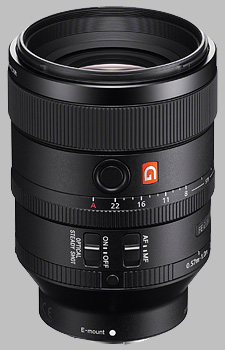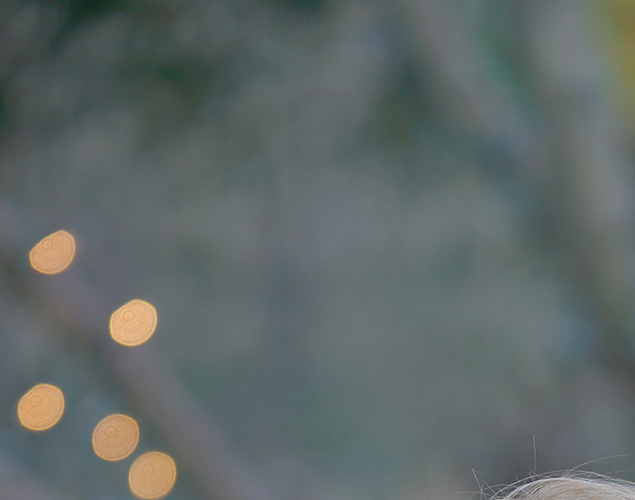| 100mm |
$1,498 average price |
|---|---|

|
|
Your purchases support this site
Buy the Sony FE 100mm f/2.8 STF GM OSS SEL100F28GM
Sony FE 100mm f/2.8 STF GM Review -- Now Shooting!
Updates:
02/17/2017: Field Test & Gallery added
Sony 100mm f/2.8 STF G Master - Field Test
It's actually an f/5.6, and kind of like an f/4, yet delivers the smoothest bokeh
By Dave Pardue and Dave Etchells | Posted: 02/17/2017
Apodization is intriguing! In short, it's a lens construction design intended to smooth out the background blur elements ("bokeh") thereby producing more pleasing and flattering portraits and other images where "super-smooth" bokeh is desired. This is something any portrait or wedding photographer will surely desire at times, and yet trying to explain apodization, even coming to grips with it at all, is another matter entirely. The Sony 100mm f/2.8 G STF has this feature incorporated into its design, and we've just gotten our hands on a pre-production sample, so let's dive right in!
Sony 100mm f/2.8 STF G Master |
Gallery images and coming to terms with apodization
My natural first inclination with this lens was to do as I usually do, and that's to try and get as many typical-use-case examples from the real world as I can for our readers in the brief time that I had, so I paired it up with the excellent Sony A7R II and headed out. For the curious who can't wait, there are plenty of real world examples below for you, and even more in our sample gallery, so head there first if you like and then come back here when you're done!
Once I had a decent set of initial real-world images, I decided to shoot a quick side-by-side against a regular "non-apodized" lens at the same focal length and aperture, as we happened to have the capable Sony 70-200mm f/2.8 G Master lens in-house at the same time. The results were surprising in several key ways, and in the course of figuring them out, we learned a lot about what apodizing filters are all about, and what the technology means to real-world photography. And more than anything else, we were more intrigued than ever to view the differences between this and a conventional lens.
...Comparison time!
Sony 100mm f/2.8 STF apodized vs 70-200mm f/2.8 non-apodized
When talking about bokeh in general and apodization in particular, most examples tend to focus on (no pun intended) bright background highlights. Good examples are bright lights, so I quickly put together a portrait shoot with little holiday lights in the background, and shot it with both this lens wide open (technically an f/2.8, but it shows f/5.6 on the LCD - stay tuned for more on this interesting discrepancy below) and with the 70-200mm f/2.8 G zoomed to approximately 100mm and wide open at f/2.8. In many ways, the results at first glance aren't overly dramatic, but upon closer inspection became very revealing indeed.
Let's zoom into the image and take a closer look at what's going on with the bokeh in a bit more detail.
Now, let's zoom all the way into those 42.4 million pixels and see the full effect on all those little holiday lights.
Tripping the light fantastic. This GIF shows the dramatic differences between how the new 100mm f/2.8 STF renders the background highlights, vs the conventional 70-200mm f/2.8. After allowing for the slight scale differences, a number of differences are evident. 1) One of the most obvious differences is the way the highlights here are flat-topped with the conventional lens. This is because the sensor doesn't have a clear, unobstructed view of the subject this far out in the frame. Rather, we're seeing the image of the aperture, clipped by the front element of the lens. The FE 100mm f/2.8 doesn't have that problem; the front element has plenty of room for light rays to pass through the lens aperture unobstructed. This is very common with large-aperture lenses; some famous ultra-bright primes are known for this sort of effect. 2) Again, what we're seeing here is basically images of the lens aperture. In the case of the conventional lens, it's a bright circle with hard edges. In the case of the lens with an onboard apodizing element, the highlights are rendered as soft blobs, gradually fading at the edges. As we saw above, this makes these background elements much less distracting to the image and subject! 3) BUT, we can also see that, while the out of focus highlights fade at their edges, the brighter ones don't quite blend smoothly into the background. Less-bright highlights do (see the blob at bottom right), but others still have somewhat hard edges to them, although the brightness difference between blob and background is much less. More on this below... |
So as you can see, the 100mm f/2.8 STF does a lot better job with the background highlights. And while apodization is far from a new idea, this lens obviously does a great job in this area. Strong highlights are just a small part of the story, though, and not the reason a bokeh fanatic would pay the price for a lens of this caliber.
As mentioned above, we noticed that the other, less-bright background elements seemed less blurred in general with the 100mm f2.8 STF, even though technically shot at the same aperture and focal length. Closer inspection of these elements shows where the real beauty of this lens begins to present itself.
It's not all rainbows and unicorns, though; there are some significant trade-offs to apodization. To understand them, we need to look at what apodization is all about.
The mechanics of apodization (a.k.a. "Smooth Trans Focus")
As we mentioned in passing above, what we're seeing in bright, out of focus highlights like the holiday lights in these photos are essentially images of the lens aperture. In the case of the conventional lens, these are bright discs with hard edges. (They do at least have fairly smooth perhipheries; that's because the 70-200mm f/2.8 G-Master lens has 9 curved aperture blades, resulting in an almost completely smooth-edged opening. Fewer, non-curved blades would produce angular edges on the highlight-discs.)
So how do you get away from distracting, hard-edged bokeh circles? By making an aperture that fades gradually to black, vs an all-or-nothing all-clear vs solid-black transition. This is what an apodization filter does.
The actual view through the wide open aperture of the Sony 100mm f/2.8 STF |
We're basically looking directly at the apodization filter here. (And note that this is the view you get with the lens in your hand, just holding it up to the light.) This light falloff isn't vignetting, nor related to it, as some media outlets have reported. An apodization filter just changes the image of the aperture, and has nothing to do with light falloff in the corners of the frame. |
The image above was shot looking into the end of the lens while one of us was holding it up against the face of a bright softbox. Rather than a bright, uniform disc, it fades gradually the further you get from the center. Note that it doesn't fade all the way to pure black, though. Remember the crops above where the dimmest lights faded cleanly into the background, while brighter ones still had hard edges? This is why. Even though the filter fades towards the edges, at some point, if you have enough light and contrast, you'll reach the limit of the filter's gradation, and end up with a hard edge again, even if one not as distracting as you'd have without the filter present. Pretty cool!
Sony 100mm f/2.8 STF G: It's actually an f/5.6.
The most immediate cost of apodization is that the process by nature reduces the available light coming through the lens, when compared to the same diameter clear aperture on a conventional lens. (This is measured as the T-stop (for light "transmission"), vs F-stop, which refers onliy to the size of the aperture relative to the focal length of the lens.) For the Sony FE 100mm f/2.8 STF G, the T-stop while wide open is the equivalent of an f/5.6 aperture. That's two full stops of light loss! Fortunately on cameras as eminently capable as the Sony A7R Mark II (winner of our Camera of the Year award for 2015) there's plenty of room to bump the ISO to compensate, before noise creeps into the picture.
People unfamiliar with apodization may be tempted to call foul: "Hey, wait a minute! I paid for an f/2.8 lens, not an f/5.6 one; I want my money's worth!".
The thing is, apodization by definition means trading away a fair bit of light, in the interest of avoiding hard edges on out of focus details. You can trade away less light (as is the case with the Fuji 56mm f/1.2 APD lens), but that just means that you're going to run into more hard-edged bokeh with less brightness difference between background elements. In the case of something like our holiday lights, we would see hard edges even on the fairly dim lights with less apodization onboard.
On the other hand, it's kind of like an f/4
It turns out that light loss isn't the only thing you give up with apodization, though, which is where matters really begin to get confusing. Shooting further tests with other lenses at f/2.8 and f/5.6, we concluded that the "effective" subject-to-background depth-of-field isolation of this lens is really like that of an f/4 optic when wide open. Recall the crops above, comparing the background blur from the FE 100mm f/2.8 STF and the 70-200mm zoom at a similar focal length. As we pointed out, the amount of blurring with the conventional lens was actually greater than with the fancy bokeh-master, a curious head-scratcher at first.
If you think about it, this makes sense though, especially with a lens like the 100mm f/2.8 STF that has such a strong apodization effect. You don't really have a clear, f/2.8 aperture; a lot of light rays from the edges of the aperture are blocked or attenuated by the gradated neutral density of the apodization filter. This means that the effective aperture is something smaller than f/2.8; in our very rough estimation, the DOF of the FE 100mm f/2.8 STM is about the same as an f/4 lens of similar focal length.
An f/2.8 that's actually an f/5.6, but shoots like an f/4
So there you have it: The Sony FE 100mm f/2.8 STF G has a physical aperture of f/2.8, but exposes like an f/5.6. And when it comes to DOF, it shoots like an f/4, but produces some of the most amazing, creamy bokeh we've ever seen. Given it's price, it's a somewhat special-purpose lens, but oh man; if you want amazing bokeh, this is the way to get it!
Sony 100mm f/2.8 STF in the real world
To give you an idea of what we're talking about in all the above, here are some real-world images shot with the FE 100mm f/2.8 STF. (Check out that buttery background!)
1/100s / f/5.6 / ISO 100 |
(All images were shot handheld with OSS enabled on the Sony A7R Mark II. Images have been resized to fit this page and altered in post, primarily to balance shadows and highlights where needed. Access to the original, full resolution images and EXIF data is available in our gallery.)
1/320s / f/5.6 / ISO 100 |
1/320s / f/5.6 / ISO 100 |
1/160s / f/5.6 / ISO 100 |
1/60s / f/5.6 / ISO 320 |
| [1:1 crop from above image to showcase lens sharpness wide open] |
1/60s / f/5.6 / ISO 640 |
Sony 100mm f/2.8 STF Conclusion
Like the bouquet of a fine french wine, good bokeh has its refined subtleties as well. Yes, with a shallower depth of field you could just wash the entire background into blurred oblivion, and that look has its place for certain needs. But more often than not, especially when you want your subject to stand out but still be a part of the background elements to a degree, your best option is to seek the smoothest bokeh available.
As we've demonstrated here, the Sony 100mm f/2.8 is in a rare class of lenses able to pull off this almost magical feat, producing a buttery smoothness to background elements even without need of a super-shallow depth of field. And the trade-off in a reduction to overall light transmission is belayed by the excellent high-ISO capabilities of cameras like the A7R II and the A7S II. In short, if you're serious about the quality of the bokeh characteristics of your wedding and portrait work, nature and wildlife, we recommend strong consideration of this amazing lens.
1/60s / f/5.6 / ISO 250 |
• Sony 100mm f/2.8 STF Gallery •
Sony FE 100mm f/2.8 STF GM Overview
(From Sony lens literature) A specially designed mid-telephoto, full-frame prime lens, the new Sony FE 100mm F2.81 STF GM OSS Telephoto Prime Lens is built to produce truly unique, magnificent and beautiful bokeh while maintaining the exceptional standard of resolution that is showcased by Sony's entire line of flagship G Master series lenses, making it a powerful photographic tool for any portrait, fashion, nature or wedding photographer.
These impressive defocus capabilities are made possible by the lens' advanced optical structure, as it features a newly designed 11-bladed aperture and a unique optical apodization lens element. Similar to a neutral density filter that increases in density towards the edges, the apodization element creates beautiful transitions of in-focus to out-of-focus areas within an image, making for exceptionally soft, smooth bokeh that adds depth and dimensionality. This allows the subjects to stand out against beautifully defocused elements in both the foreground and background, producing an image that is naturally pleasing to the eye. The design of the lens also ensures that vignetting is kept to an absolute minimum, ensuring optimum image quality.
Additionally, the new 100mm lens supports both contrast AF and focal-plane phase detection AF2, and has a high-precision, quiet direct drive SSM (Super Sonic Motor) system that ensures exceptionally fast and accurate AF performance. The SEL100F28GM also offers up to 0.25x close-up capabilities with a built-in macro switching ring, built-in Optical SteadyShot™ image stabilization, a customizable focus hold button, AF/MF switch, aperture ring and more. It is dust and moisture resistant as well.3
The FE 100mm F2.8 STF OSS GM Telephoto Prime Lens will ship this March for about $1,500 US and $2,050 CA.
1. T-number (T) =5.6
2. With compatible α camera bodies. Please visit Sony support webpages for details.
3. Not guaranteed to be 100% dust and moisture proof.
Sony FE 100mm f/2.8 STF GM OSS SEL100F28GM
Your purchases support this site
Sony E-mount - Black
Sony FE 100mm f/2.8 STF GM OSS SEL100F28GM User Reviews
-
Best apodization yet; No vignetting nor flare, very high sharpness; AF works quite well despite apodization; OSS works well, helps with non-IBIS bodies and sort-of compensates for light loss due to apodizer; Handles like a G lens$1500; Not small (it doesn't vignette at f/2.8!); Build uses a lot of plastic; Close focus, but unfortunately not macro; Light loss from apodization filter (even when lens is stopped down and not apodizing) -- pity the apodizer isn't removable
This is a truly excellent lens that also happens to be apodized (seemingly to slightly better effect than the Minolta 135mm STF, significantly better than the Laowa 105mm STF, and way better than my homemade apodizers). Basically, this is the new king of smooth bokeh -- but it would be more accurate to think of it as the ultimate lens for making images that are all about the primary subject, because the lack of vignetting and flare combining with high sharpness and smooth bokeh essentially eliminate all distractions. Thus, I think this lens is best suited for wide-open use on portraits and product photography. The smooth bokeh also helps minimize artifacting for focus stacking, and IQ seems still good on extension tubes for getting into the macro range.
reviewed May 10th, 2017 (purchased for $1,500)
I posted a little review at DPReview last week, including some sample photos: https://www.dpreview.com/forums/post/59510810

